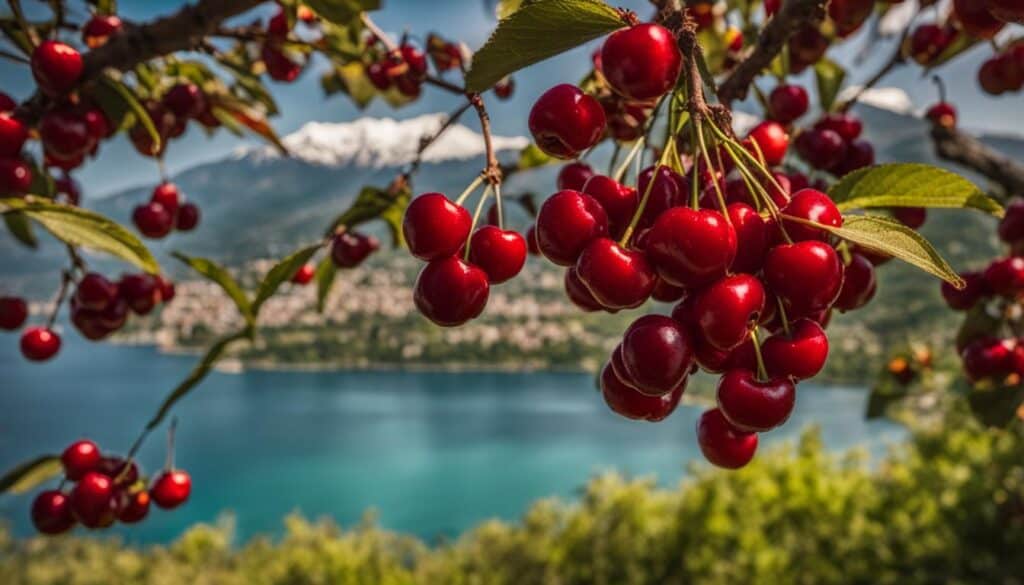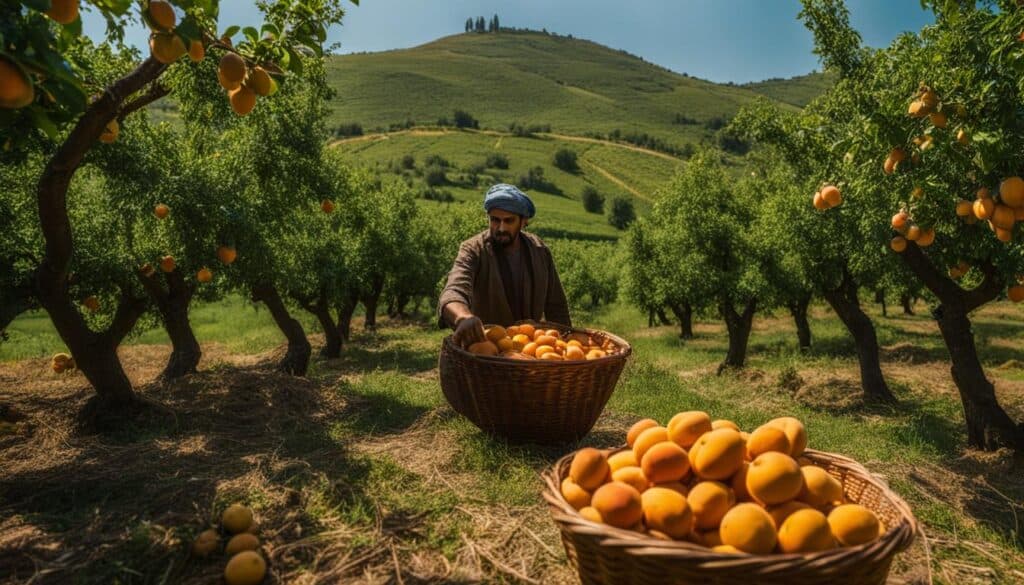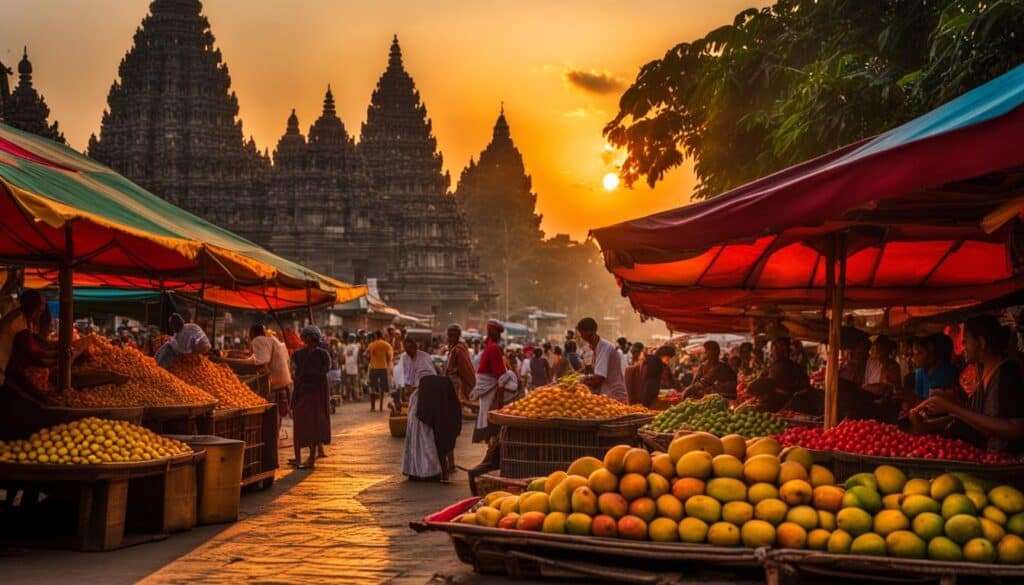Fruits have always held a special place in our cultures, representing more than just nourishment. They are the fruit of a country’s soil, the embodiment of its identity and heritage. Each national fruit carries with it a distinct flavor, telling a story of rich history and vibrant culture. Join me on this mouthwatering journey as we explore the emblematic fruits of different countries, their significance, and the unique tales they share.
As we delve into the world of national fruits, we will discover their cultural significance and uncover the diversity they represent. From the official fruits that proudly adorn national emblems to the native fruits that capture the essence of a region, each iconic fruit holds a story waiting to be savored.
Key Takeaways:
- National fruits are more than just a source of nutrition; they are symbols of identity and heritage.
- Exploring national fruits allows us to connect with different cultures and traditions.
- Each national fruit reflects the unique flavors and stories of its homeland.
- National fruits showcase the rich diversity of our world’s natural landscapes.
- Embark on a flavorful journey and discover the cultural fruits that define our nations.
Pomegranate: Afghanistan and Iran
In Persian culture, the pomegranate holds deep mythological significance. It is considered a symbol of fertility and prosperity, often associated with the ancient goddess Anahita. The vibrant ruby-red seeds of the pomegranate represent the cycle of life and offer a promise of a prosperous future.
Persian art is adorned with motifs of pomegranates, from intricate pottery designs to elaborate carpet patterns. This fruit’s rich symbolism is intertwined with Persian heritage and is celebrated in various aspects of daily life.
Pomegranates are more than just a delicious fruit; they are a powerful emblem of our culture. Their presence in Persian art and mythology reflects the importance we place on fertility, prosperity, and the cycle of life.
Whether enjoyed fresh or incorporated into dishes, the pomegranate continues to be a cherished part of the culinary traditions in Afghanistan and Iran. Its unique flavor and cultural significance make it a true gem of the region.
Pomegranate Fun Facts:
- The word “pomegranate” is derived from Latin, meaning “apple with many seeds.”
- Pomegranates are classified as berries and can contain hundreds of edible seeds called arils.
- The pomegranate tree has been grown for thousands of years and is native to the region spanning from Iran to the Himalayas.
- Pomegranate juice is known for its antioxidant properties and is believed to have various health benefits.
Pomegranate Recipe: Persian Pomegranate Salad
| Ingredients | Instructions |
|---|---|
|
|
Experience the enchantment of pomegranates by trying this delightful Persian Pomegranate Salad. Its vibrant colors and refreshing flavors will transport you to the heart of Afghanistan and Iran.
Cherry: Albania

In Albania, cherries are more than just a delicious fruit. They hold a special place in the nation’s agricultural traditions and are deeply ingrained in Albanian culture. Cherries thrive in the country’s fertile soil and are cherished for their sweet and juicy flavor.
The Albanian cherry season, which typically runs from May to July, is a time of celebration and abundance. Families and communities come together to harvest the cherries, fill baskets with their vibrant red fruits, and enjoy them fresh. The cherry harvest is not only a source of sustenance but also a testament to Albania’s rich agricultural heritage.
Cherries are not limited to being enjoyed fresh; they are also used in various culinary creations. In Albania, cherries are transformed into delectable jams and desserts, showcasing the versatility of this beloved fruit. One popular Albanian delicacy is “Visniak,” a cherry liqueur that captures the essence of this national fruit in a bottle.
Cherry Harvest in Albania
“The cherry harvest in Albania is a time of joy and togetherness. It brings communities closer as they gather under the cherry trees, plucking the ripe fruits and savoring their sweet juiciness. It’s a tradition that has been passed down through generations and continues to unite Albanians in their love for this iconic fruit.”
Dates: Algeria and the United Arab Emirates
Dates hold a special place in the cultures of Algeria and the United Arab Emirates, where they are not only a staple food but also a symbol of resilience and resourcefulness. These desert fruits have been cultivated for thousands of years, showcasing the ability of these nations to thrive in the harshest conditions.
“Dates represent the very essence of our culture and history. They have been our source of sustenance for generations, providing nourishment and strength in the face of adversity,” says Ahmed, a date farmer from Algeria.
In Algeria, dates are not only enjoyed fresh but are also integrated into traditional dishes and desserts. They are a common ingredient in Algerian cuisine, adding a natural sweetness and depth of flavor to various recipes. In the United Arab Emirates, dates are not only eaten as a snack but are also a cherished gift symbolizing hospitality and generosity.
These dried fruits are known for their nutrient-rich composition, making them a valuable source of energy. They are packed with essential minerals, vitamins, and antioxidants, offering numerous health benefits. Dates are also used in the production of date syrup, a sweet and versatile ingredient used in confectioneries and beverages.
“Dates are more than just a fruit to us. They are a reflection of our heritage and the resilient spirit of our people,” shares Fatima, a date farmer from the United Arab Emirates.
| Country | Key Features |
|---|---|
| Algeria | Long history of date cultivation; dates as a symbol of resilience and resourcefulness; integral part of Algerian cuisine |
| United Arab Emirates | Significant cultural significance; dates as a representation of hospitality and generosity; utilization of dates in traditional dishes and desserts |
Both Algeria and the United Arab Emirates proudly celebrate the significance of dates in their cultures, honoring the heritage and tradition associated with these remarkable fruits. Whether enjoyed fresh or incorporated into diverse culinary creations, dates continue to play a vital role in the daily lives and customs of these nations.
Palm: Angola

Angola’s national fruit, the palm, is a versatile fruit that plays a vital role in the country’s sustainable development. The palm tree itself is a symbol of Angola’s lush natural resources, providing both food and materials for local communities. Palm fruits are used to make oil, which is a staple ingredient in Angolan cuisine and an essential source of income for many.
One of the remarkable characteristics of the palm fruit is its versatility. The oil extracted from the fruit is not only used for cooking but also for cosmetics, soaps, and biodiesel production, making it a valuable resource for Angolans. The palm tree’s sustainable nature ensures its continued contribution to the country’s economy and promotes self-reliance.
Furthermore, the palm tree’s significance goes beyond its fruit. It is used in traditional construction, providing materials for roofing and building structures in rural communities. This utilization of the palm tree exemplifies Angola’s commitment to sustainability and showcases the resourcefulness of its people.
Through its versatile fruit and the sustainable utilization of its resources, the palm tree symbolizes Angola’s ability to thrive in harmony with its environment. It is a prime example of how a national fruit can represent a country’s commitment to sustainability, cultural heritage, and economic prosperity.
Pineapple: Antigua and Barbuda
When it comes to tropical fruits, the pineapple reigns supreme in Antigua and Barbuda. This vibrant yellow fruit with its distinctive crown is not only a delicious tropical treat but also a symbol of the warm hospitality the islands are known for. The pineapple’s sweet and tangy flavor perfectly encapsulates the essence of the Caribbean, making it a fitting choice as the national fruit of Antigua and Barbuda.
In Antigua and Barbuda, the pineapple is grown abundantly, thriving in the island’s tropical climate. Its juicy flesh and refreshing taste make it a popular ingredient in local cuisine, from refreshing fruit salads to mouthwatering desserts like pineapple upside-down cake. The pineapple’s versatility extends beyond the realm of food, as it is also used in traditional arts and crafts, such as intricate wood carvings and vibrant textile designs.
“The pineapple is not only a tropical fruit; it represents the warm and welcoming spirit of our people. Just like the pineapple’s prickly exterior hides its sweet and juicy flesh, we believe in extending a warm embrace to visitors and making them feel at home in our beautiful islands.” – Local resident of Antigua
The Hospitality of Pineapple
The pineapple’s association with hospitality dates back centuries. In colonial times, the pineapple was a rare and prized fruit, often reserved for special occasions and offered as a sign of welcome and friendship. This tradition has endured, and today the pineapple remains a symbol of hospitality and warm greetings.
Whether it’s served as a refreshing tropical drink at beachside bars or as a centerpiece at lively gatherings, the pineapple’s presence is ubiquitous in Antigua and Barbuda. Its symbol can be spotted in local customs, such as the pineapple-shaped mailbox, which serves as a cheerful welcome to all who pass by.
| Interesting Facts about Pineapple in Antigua and Barbuda |
|---|
| 1. Pineapples are not only enjoyed for their taste but also appreciated for their health benefits. They are rich in vitamins, minerals, and antioxidants that support overall well-being. |
| 2. The pineapple is not only the national fruit of Antigua and Barbuda but also serves as a symbol of the islands’ agricultural heritage. |
| 3. The pineapple is believed to have originated in South America and was brought to the Caribbean by European explorers. |
| 4. The spiky exterior of the pineapple serves as a natural defense mechanism, protecting the sweet and succulent fruit inside. |
As you explore the vibrant culture and breathtaking landscapes of Antigua and Barbuda, be sure to indulge in the tropical delight that is the pineapple. Its warm and inviting flavor will leave a lasting impression as you experience the true essence of the islands’ hospitality.
Apple: Argentina and Austria
Apples are not just a popular fruit, but they also hold a special place as national fruits in both Argentina and Austria. These versatile fruits have become global icons, enjoyed in various forms and used in a wide range of culinary creations. The apple’s significance goes beyond its delicious taste, representing the cultural heritage and agricultural prowess of these two nations.
In Argentina, apples have been cultivated since the 16th century when Spanish colonizers introduced them. Today, Argentina is one of the leading apple producers in the world, renowned for its high-quality fruit. Argentinean apples are known for their crisp texture, succulent juiciness, and vibrant flavors. They are enjoyed fresh, baked into pies, or transformed into refreshing juices, showcasing the versatility of this beloved fruit.
In Austria, apples also play a significant role in culinary traditions. Apple strudel, one of the country’s most famous and cherished desserts, showcases the sweetness and tanginess of apples. This delectable pastry, made with layers of flaky dough filled with apple slices, cinnamon, and raisins, has become an iconic symbol of Austrian cuisine. Whether enjoyed as a warm treat with a dollop of vanilla ice cream or served cold as a delightful accompaniment to a cup of coffee, apple strudel brings joy and comfort to locals and visitors alike.
The apple’s ability to adapt to different climates, its year-round availability, and its versatility in culinary applications have made it a beloved fruit in both Argentina and Austria. Whether it’s a crisp and juicy bite of an Argentinean apple or a heavenly slice of apple strudel in Austria, these national fruits symbolize the rich flavors and cultural heritage that make these countries truly unique.
Apple Varieties in Argentina and Austria
| Apple Variety | Argentina | Austria |
|---|---|---|
| Red Delicious | ✓ | |
| Gala | ✓ | ✓ |
| Granny Smith | ✓ | |
| Golden Delicious | ✓ |
“Apples are not only delicious but also a symbol of our agricultural heritage and the resilience of our farmers.” – Juan Martinez, an apple farmer in Argentina
While Argentina and Austria share the apple as their national fruit, they have their own unique apple varieties that thrive in their respective climates. In Argentina, popular apple varieties include the Red Delicious, Gala, and Granny Smith, each offering its own distinct flavor profile. Meanwhile, Austria is known for its cultivation of apples such as the Gala and Golden Delicious, which are prized for their sweetness and versatility in cooking and baking.
Whether you bite into a juicy Argentinean apple or savor a slice of apple strudel in Austria, these national fruits will surely leave you with a taste of their rich cultural heritage and the exceptional flavors that define these nations.
Apricot: Armenia

Armenia, known as the “Land of Apricots,” takes great pride in its national fruit, the apricot. With its golden hue and succulent flavor, the apricot epitomizes the fertile land and vibrant culture of this ancient nation.
The apricot holds a special place in Armenian folklore, where it is revered as a symbol of abundance and good luck. Its luscious flesh and delicate aroma have made it a staple ingredient in traditional Armenian cuisine, finding its way into jams, desserts, and a variety of delectable dishes.
Armenia’s favorable climate and rich soil provide the ideal conditions for cultivating apricots of exceptional quality. The country celebrates this beloved fruit with festivals and events, where locals and visitors alike indulge in its mouthwatering sweetness.
Whether enjoyed fresh or preserved, the apricot embodies the spirit of Armenia, showcasing the resilience of its people and the bountiful gifts of its land. It is a cherished symbol of the country’s heritage, inviting both locals and tourists to savor its irresistible taste and experience the cultural richness it represents.
Mango: India, Pakistan, and the Philippines

When it comes to national fruits, mangoes reign supreme in India, Pakistan, and the Philippines. Regarded as the “king of fruits,” mangoes hold immense cultural significance in these countries, representing their rich heritage and love for tropical flavors.
The mango is not just a fruit; it is a symbol of abundance, sweetness, and prosperity. Its juicy flesh and distinct aroma have enchanted generations, making it a staple ingredient in various dishes and beverages. Mangoes are enjoyed in their pure form, added to salads, blended into luscious smoothies, and used to create mouthwatering desserts.
The mango is not just a fruit; it is a symbol of abundance, sweetness, and prosperity.
The cultural significance of mangoes goes beyond their culinary uses. In India, mangoes are associated with love and fertility, often depicted in ancient artwork and literature. The fruit is closely intertwined with cultural festivals and celebrations, such as the Hindu festival of Holi, where mangoes are shared as a gesture of goodwill and friendship.
In Pakistan and the Philippines, mangoes play a vital role in the economy, with both countries being major exporters of this tropical delight. The fruit showcases the agricultural prowess of these nations and serves as a source of employment for many farmers.
| Country | Mango Varieties | Characteristics |
|---|---|---|
| India | Alphonso, Kesar, Langra | Sweet, fragrant, creamy |
| Pakistan | Chaunsa, Sindhri, Anwar Ratol | Juicy, aromatic, fiber-free |
| Philippines | Carabao, Pico, Indian Mango | Rich, tangy, fiber-free |
With their vibrant colors and tantalizing taste, mangoes encapsulate the essence of India, Pakistan, and the Philippines. They are an integral part of the cultural fabric, symbolizing the warmth, diversity, and tropical delights that these nations have to offer.
Durian: Indonesia, Malaysia, and Singapore
The durian, a polarizing delicacy, is a fruit that elicits strong reactions from people around the world. With its unique flavor and infamous aroma, it has become a cultural phenomenon in Indonesia, Malaysia, and Singapore. This spiky fruit is loved and loathed in equal measure, making it a fascinating subject of discussion among food enthusiasts.
Known as the “king of fruits,” the durian is cherished for its rich, creamy texture and distinct taste. Its flavor profile is often described as a combination of sweet, savory, and slightly bitter notes. Some liken it to a custard-like indulgence, while others find its taste too overpowering.
Indonesia, Malaysia, and Singapore have embraced the durian as a culinary treasure, incorporating it into various dishes and desserts. From durian pancakes and ice cream to durian pastries and cakes, the possibilities are endless. The fruit’s versatility allows chefs and food enthusiasts to experiment with its unique flavor, creating a range of delicacies that cater to different palates.
The Durian in Numbers:
| Country | Production (in metric tons) | Major Varieties |
|---|---|---|
| Indonesia | 1,268,050 | Montong, Monthong, Bawor, Petruk |
| Malaysia | 341,000 | D24, Musang King, XO, Red Prawn |
| Singapore | Not Applicable | Imported |
Despite its divisive reputation, the durian continues to captivate locals and adventurous travelers alike. It is an experience that must be savored to truly appreciate the complexities of Southeast Asian cuisine. So, whether you’re a fan or a curious explorer, don’t miss the opportunity to embark on a durian adventure when visiting Indonesia, Malaysia, or Singapore.
Conclusion
National fruits hold immense cultural significance, serving as a delightful window into the diversity and heritage of different countries. These fruits not only nourish our bodies but also connect us to the rich tapestry of traditions, stories, and landscapes that define each nation.
Exploring national fruits is like embarking on a global culinary adventure, offering a tantalizing taste of the world. From the fertile lands of Armenia, where the apricot reigns supreme, to the tropical paradise of Antigua and Barbuda, where the pineapple symbolizes hospitality, every fruit carries a unique story that reflects the essence of its homeland.
By savoring these national fruits, we celebrate the richness of cultural heritage and the beauty of our world’s diverse ecosystems. Whether it’s sampling the sweet and tangy mangoes of India, Pakistan, and the Philippines or indulging in the complex flavors of the durian in Indonesia, Malaysia, and Singapore, each bite allows us to connect with the flavors, traditions, and people of a distant land.
So, let’s embark on a journey of world exploration through national fruits. As we savor the unique tastes, let’s also embrace the opportunity to learn, appreciate, and celebrate the cultural significance that these fruits encapsulate. National fruits truly embody the beautiful tapestry of diversity that makes our world so extraordinary.
FAQ
What is a national fruit?
A national fruit is a fruit that is officially designated as a symbol of a particular country. It represents the cultural and historical significance of that nation.
How are national fruits chosen?
National fruits are often chosen based on their historical, cultural, or agricultural significance to the country. They may also reflect the unique flavors and characteristics of the nation.
Are national fruits only eaten in their respective countries?
National fruits are often enjoyed locally, but they can also be exported and enjoyed by people around the world. They serve as ambassadors of the country’s culinary heritage.
Can national fruits be used in recipes?
Yes, national fruits can be incorporated into a variety of dishes, including desserts, jams, liqueurs, and savory dishes. They add a unique flavor and cultural touch to the cuisine.
Are national fruits only symbolic or do they have nutritional value?
National fruits are both symbolic and nutritious. They offer a range of health benefits due to their natural vitamins, minerals, and antioxidants. They are often part of a healthy diet.
Are national fruits celebrated in festivals or events?
Yes, many countries celebrate their national fruits through festivals and events. These celebrations often highlight the cultural significance and culinary traditions associated with the fruit.
Can I grow national fruits in my own garden?
Depending on the climate and growing conditions, some national fruits can be grown in home gardens. However, certain fruits may require specific environmental conditions for optimal growth.
Where can I buy national fruits if they are not available in my country?
National fruits can often be found in international markets or specialty stores that focus on imported produce. Online retailers may also offer the opportunity to purchase these fruits.
Are there any legends or stories associated with national fruits?
Yes, many national fruits have legends or stories that are deeply rooted in the cultural heritage of the country. These stories often reflect the values and traditions of the nation.
Can national fruits be a symbol of national identity?
Absolutely! National fruits are often seen as a symbol of national identity, representing the unique flavors, traditions, and natural resources of a country. They evoke a sense of pride and connection.





Leave a Reply